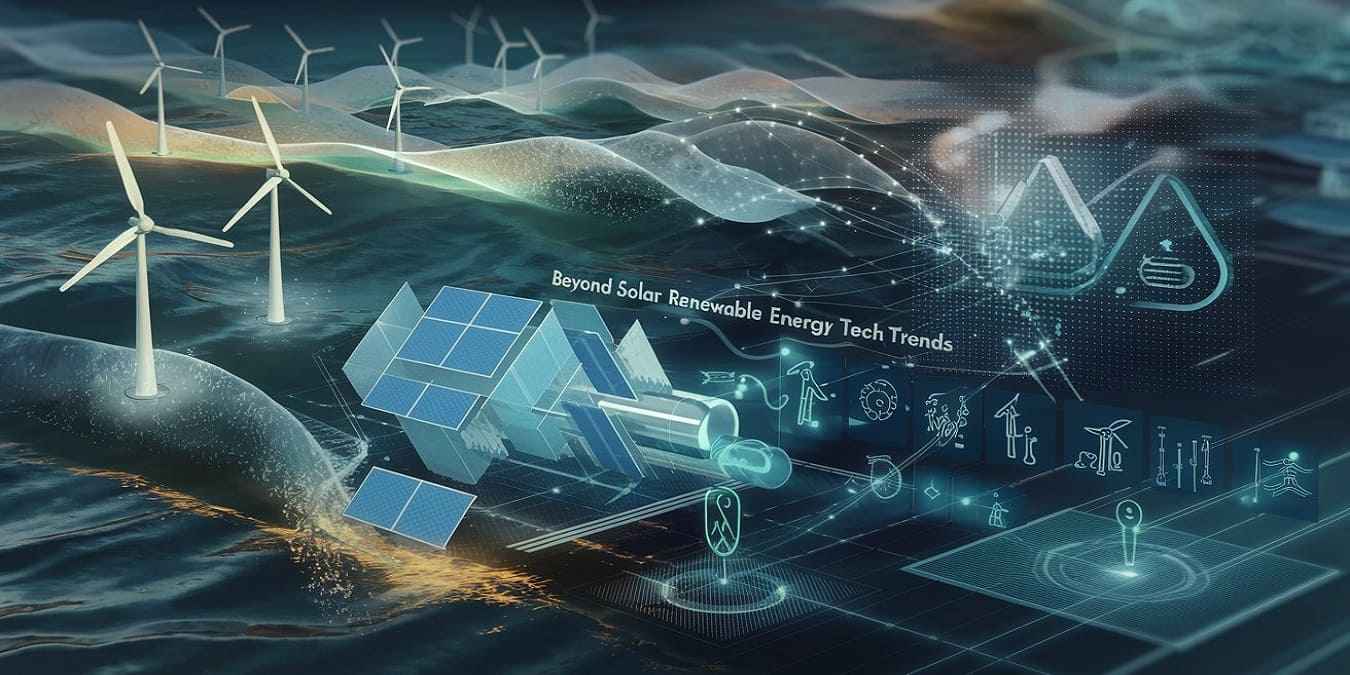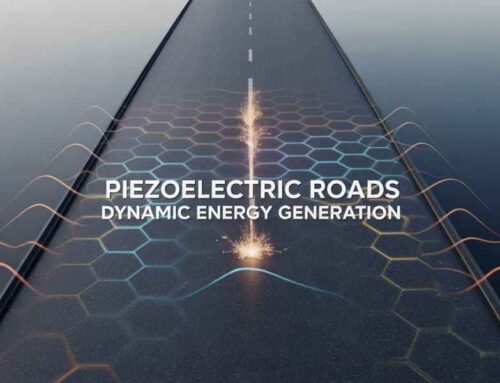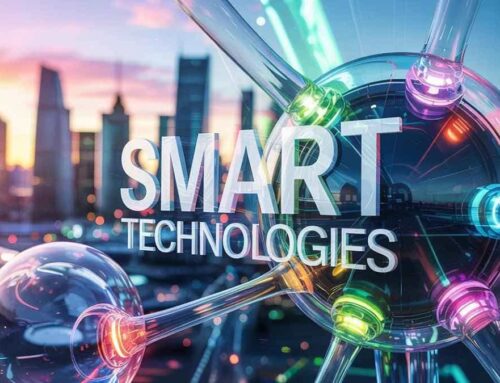
Beyond Solar: Innovative Renewable Energy Tech Trends
“The future will be green.” – Elon Musk
If you’ve ever wondered what lies beyond the familiar sight of solar panels dotting rooftops, you’re not alone. While solar energy has long been the poster child of renewable energy, the world of clean tech is exploding with innovations that go far beyond photovoltaic cells. From floating wind farms to hydrogen-powered economies, the next wave of renewable energy tech trends promises to reshape how we power our lives and our planet.
In this article, we’ll dive into the cutting-edge advancements propelling us beyond solar energy. Whether you’re a sustainability advocate, a tech enthusiast or a business leader eyeing the future, these trends will redefine what’s possible in the quest for a greener world.
Let’s explore the horizon of renewable energy together.
Why Look Beyond Solar?
Solar energy has undoubtedly revolutionized the renewable sector. But relying solely on one technology leaves gaps in reliability, scalability and efficiency. What happens on cloudy days or in regions with limited sunlight? How do we power energy-hungry industries like manufacturing or aviation?
The answer lies in diversifying our renewable portfolio. By embracing emerging technologies, we can create a more resilient, adaptable energy system.
“The Stone Age didn’t end because we ran out of stones; we transitioned to better solutions.” – Sheikh Zaki Yamani
Let’s unpack the innovations driving this shift.
-
Floating Wind Farms: Harnessing Ocean Power
When you think of wind turbines, you might picture rows of giants on hillsides. But what if we told you the future of wind energy is floating? Floating offshore wind turbines are anchored to the seabed, allowing them to operate in deeper waters where winds are stronger and more consistent.
Projects like Hywind Scotland, the world’s first floating wind farm, have already proven the concept’s viability. These turbines can generate power even in stormy conditions, making them ideal for coastal regions. By 2030, floating wind could account for 10% of global offshore wind capacity.
Why it matters: Floating turbines unlock vast untapped energy potential in oceans, reducing land-use conflicts and expanding clean energy access.
-
Green Hydrogen: Fueling Heavy Industries
Solar and wind excel at generating electricity, but industries like steelmaking, shipping and aviation require high-heat processes or dense energy storage. Enter green hydrogen, produced by splitting water with renewable energy-powered electrolysis.
Countries like Germany and Japan are investing billions in green hydrogen infrastructure, aiming to replace fossil fuels in sectors where electrification isn’t feasible. For example, hydrogen fuel cells could power cargo ships or even airplanes, slashing emissions from transportation.
Ask yourself: Could hydrogen become the “Next Oil” for industries too tough to decarbonize?
-
Agri-PV: Farming and Solar Synergy
What if we could grow crops and generate power on the same land? Agrivoltaics (Agri-PV) or Dual Use Solar integrates solar panels with agriculture, creating a symbiotic relationship. Panels provide shade for crops, reducing water evaporation, while crops cool the panels, boosting efficiency.
In Japan, agrivoltaic systems have shown the potential to sustain rice yields at 80% or higher of their original levels while producing clean energy, achieved through shading rates optimized between 27% and 39%. These systems enhance land functionality by integrating renewable energy generation with agricultural practices.
Key insight: It’s not just about energy, it’s about reimagining how we use space.
-
Perovskite Solar Cells: The Next Solar Frontier
Solar isn’t disappearing, it’s evolving. Perovskite solar cells, made from abundant materials like calcium and titanium, promise higher efficiency and lower costs than traditional silicon cells.
These flexible, lightweight cells can be printed on surfaces like windows or car roofs, opening up new applications. Oxford PV, a leading innovator, has achieved 33% efficiency in lab tests, far surpassing silicon’s 22%.
Why it’s exciting: Imagine solar power generated from skyscraper windows or electric vehicle bodies.
-
Bifacial Solar Panels: Doubling Down on Efficiency
Traditional solar panels capture light on one side. Bifacial panels absorb sunlight on both sides, increasing energy output by up to 27%. Paired with reflective surfaces or trackers that follow the sun, they’re ideal for deserts or snowy regions where light reflects off the ground.
Practical example: A bifacial installation in Chile’s Atacama Desert generates 40% more energy than conventional panels.
-
Advanced Energy Storage: Beyond Lithium-Ion
Solar and wind are intermittent, so storage is key. While lithium-ion batteries dominate today, innovations like zinc-air batteries and gravity storage (using heavy weights to store energy) offer safer, cheaper alternatives.
Tesla’s Megapack and Form Energy’s iron-air batteries are already scaling long-duration storage, enabling renewables to power grids 24/7.
Think bigger: What if we could store weeks’ worth of energy, not just hours?
-
AI-Driven Energy Management
Artificial intelligence isn’t just for tech giants. AI optimizes renewable energy grids by predicting weather patterns, balancing supply and demand and reducing waste. For instance, Google’s DeepMind cut energy use in data centers by 40% using machine learning.
Future vision: Imagine a smart grid that auto-adjusts your home’s energy use based on real-time solar/wind availability.
-
Nuclear Fusion: The Holy Grail of Clean Energy
Nuclear fusion, the process that powers the sun, has long been the ultimate clean energy dream. Recent breakthroughs, like those at ITER and Commonwealth Fusion Systems, suggest it’s closer than ever.
If achieved, fusion could provide limitless, carbon-free energy with no radioactive waste. Bill Gates-backed startups are racing to build compact fusion reactors by 2030.
Big question: Could fusion finally end our reliance on fossil fuels?
-
Geothermal Innovations: Tapping Earth’s Heat
Geothermal energy has been around for decades, but Enhanced Geothermal Systems (EGS) now allow drilling deeper into hotter rock, expanding its potential beyond volcanic regions.
Companies like Fervo Energy are using fracking tech (sans the environmental toll) to create geothermal reservoirs anywhere. A pilot project in Nevada now powers 2600 homes.
Why now: With EGS, geothermal could supply 24/7 clean energy to 25% of the U.S. by 2050.
-
Wave and Tidal Energy: The Ocean’s Untapped Power
The ocean’s motion holds immense energy potential. Wave energy converters and tidal turbines capture kinetic energy from tides and waves, providing predictable power.
Scotland’s MeyGen project, the world’s largest tidal array, already generates enough electricity for 6,000 homes currently.
Challenges remain: Corrosion and marine life impact are hurdles, but innovations in materials and design are paving the way.
“The answer to a sustainable future isn’t blowing in the wind, it’s flowing in the tides.” – Unknown
The Road Ahead: Integrating Renewable Energy Tech Trends
The future of renewable energy isn’t a competition between technologies, it’s a symphony. Solar will remain vital, but combining it with wind, hydrogen, storage and AI creates a robust, flexible system.
For businesses, adopting these trends means staying competitive. For individuals, it’s about demanding smarter, cleaner solutions. As Musk said, the future will be green, but only if we act now.
“Innovation is taking two things that already exist and putting them together in a new way.” – Tom Freston.
Final Thoughts: Beyond Solar, Toward a Sustainable Tomorrow
We stand at a pivotal moment. The renewable energy tech trends outlined here, from floating turbines to fusion, prove that a sustainable future is within reach. The question isn’t whether we can move beyond solar, but how quickly we embrace these innovations.
As British historian, explorer and activist Robert Swan says, “The biggest threat to our planet is the belief that someone else will save it.” The power to act lies with governments, corporations and you.
By diversifying our energy mix and investing in breakthroughs, we can build a world where clean power is abundant, affordable and accessible to all. The sun isn’t setting on solar, it’s rising on a new era of renewable energy.
What role will you play in this green revolution?
FAQs
Q: What are the top renewable energy technologies to watch?
A: Key innovations include floating offshore wind farms, green hydrogen production, perovskite solar cells, advanced energy storage systems (For example, zinc-air and gravity storage) and nuclear fusion. Agri-PV and wave/tidal energy are also emerging as impactful solutions.
Q: What challenges does the renewable energy sector face?
A: Major hurdles include grid infrastructure limitations, regulatory barriers, financing gaps and ensuring energy reliability during the transition from fossil fuels. Collaboration across industries and governments is critical to overcoming these issues.
Q: Are there alternatives to traditional lithium-ion batteries for energy storage?
A: Yes. Promising alternatives include sodium-ion batteries (cost-effective and sustainable), flow batteries (long-duration storage), zinc-based chemistries and gravity storage systems. These address lithium’s environmental and scalability concerns.
Q: How do floating offshore wind farms work?
A: Floating turbines are anchored to the seabed in deep waters, where wind speeds are stronger and more consistent. This design expands usable locations for wind energy, especially in regions with limited shallow coastal areas.
Q: What is green hydrogen and why is it important?
A: Green hydrogen is produced using renewable energy to split water into hydrogen and oxygen. It’s vital for decarbonizing industries like steelmaking, shipping and aviation, where direct electrification is challenging.
Q: How can solar and wind energy complement each other?
A: Solar generates power during the day, while wind often peaks at night. Combining both creates a more stable energy supply, reducing reliance on backup systems and improving grid resilience.
Q: What role does AI play in renewable energy management?
A: AI optimizes energy grids by predicting weather patterns, balancing supply and demand in real time and reducing waste. For example, machine learning has slashed energy use in data centers by 40%.
Q: What are Enhanced Geothermal Systems (EGS)?
A: EGS involve drilling deeper into hotter rock layers to expand geothermal energy potential beyond naturally active volcanic regions. This could provide 24/7 clean power to broader areas.
Q: How are solar panels being innovated beyond traditional designs?
A: Perovskite solar cells offer higher efficiency (33% vs. silicon’s 22%) and flexibility for use in windows or vehicles. Bifacial panels capture sunlight on both sides, boosting output by up to 27%.
Q: What is the future of nuclear fusion?
A: Fusion aims to replicate the sun’s energy process, offering limitless clean power without radioactive waste. Recent breakthroughs suggest compact reactors could be operational by 2030.















I feel this is among the such a lot important information for me. And i’m happy reading your article. The web site style is wonderful, the articles is really nice :D. Good activity, cheers.